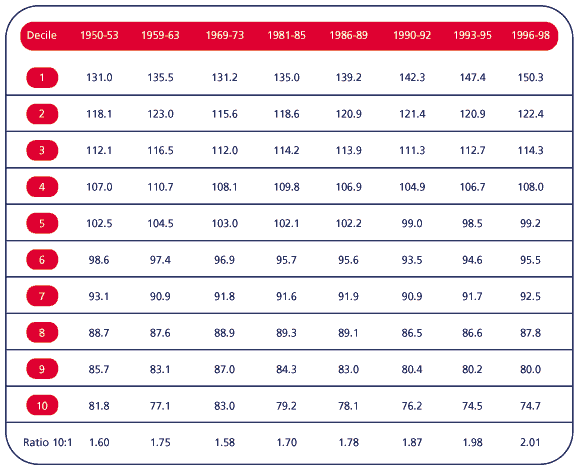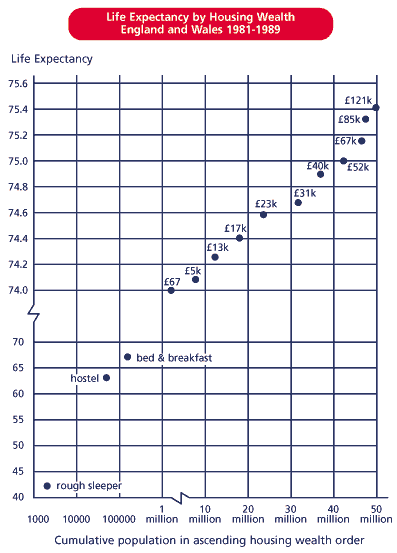 |
Close
window to return
|
Issue 3, May 2000
Housing wealth and community health: exploring the role
of migration
Danny Dorling, Mary Shaw and Nicola Brimblecombe
- Many studies have shown that within Britain there are geographical patterns in mortality, with death rates being higher in urban compared to rural areas and higher in the north than in the south.
- Here we look at the changing geography of mortality in Britain from the 1950s (for county boroughs grouped into deciles) and report a spatial polarisation of mortality which began in the early 1980s and continued to grow wider into the late 1990s.
- A number of factors might account for the spatial polarisation of mortality, including the characteristics of people living in certain areas, or the characteristics of the areas themselves. Much evidence points to the importance of the increase in poverty and the polarisation of material well-being as being the primary driving force behind the polarisation in life chances.
- However, relatively little attention has been paid to the possible explanatory role of lifetime migration. Areas with high mortality rates also tend to be areas which have had declining populations for a long period of time.
- Analysis of deaths of participants of the BHPS found that, at the regional level, selective migration has no impact on the geography of mortality. However, at the smaller district level, the results suggest that migration has an important role to play in explaining spatial inequalities in health in the long-term.
- The study linked migration to housing tenure. It has long been known that housing and health are related, but analyses have tended to be limited to the three categories of housing tenure: owner occupation, privately rented accommodation and social housing.
- We also consider life expectancy in terms of categories of housing wealth, and also present estimates of the life expectancy of the homeless and vulnerably housed.
- Fluctuations in the housing market, the provision of social housing and the general affordability of housing are related to migration patterns, which in turn affect the geography of premature mortality seen across Britain in the 1980s and 1990s.
- Policies which reduce income inequalities, increase the quantity and quality of social housing and regulate privately rented accommodation will reduce social and spatial inequalities in health both directly and indirectly by altering migration patterns.
Background
The spatial
polarisation of mortality in Britain
Britain
has long been scarred by geographical inequalities in health, with, on
average, death rates being higher in the north than in the south and higher
in urban than in rural areas. Recently, researchers have also reported
a geographical polarisation of life chances in Britain and we update this
evidence.
Table 1 shows standardised mortality ratios (SMRs) for deaths under the age of 65 from the early 1950s to the late 1990s for 292 county boroughs of Britain (see Dorling, 1997 for more details). We focus on deaths under 65 as these are generally considered to be premature. SMRs, or more precisely, age-sex-standardised mortality ratios, refer to the ratio of the number of deaths observed in the study group or population to the number that would be expected if the study population had the same age-sex-specific rates as the standard population, multiplied by 100. Rather than listing individual areas, we have divided them into deciles of population, ranked by SMR. Decile 1 contains the ten percent of the population living in areas with the highest SMRs, or the greatest chances of dying prematurely, and decile 10 contains the ten percent of the population living in areas with the lowest SMRs. This technique allows us to make a comparison between the worst and best off areas (in terms of health) over four decades.
The results show a spatial polarisation of mortality over the past two decades - areas which already had the lowest death rates have experienced the greatest reductions in mortality, whereas areas with the highest death rates have experienced negligible improvements in life chances. Geographical inequalities in mortality now stand at the highest levels ever recorded. The gap is such that, compared to the national average, people living in the worst mortality deciles (of historically comparable areas) between 1996 and 1998 were 50 per cent more likely to die in any year before the age of 65.
Table 1: Age-sex
SMR for deaths under 65 in Britain by deciles of population (grouped by
old county borough and ranked by SMR), Britain 1950-1998

2.01 Source:
analysis by authors. Note: The standard population is the population of
England and Wales for each time period
Explaining the geography of ill-health
The role of migration
Various
explanations have been proposed for the geographical patterning of premature
mortality in Britain. A significant debate surrounds the issue of whether
these differences are due to 'people' or 'places': or in other words,
the relative contribution of compositional and contextual factors. Considering,
in particular, processes over time and the social and spatial polarisation
of mortality which has occurred in Britain since the early 1980s, there
is a great deal of evidence to suggest that this was preceded by a social
and spatial polarisation of material well-being, as indicated by income
and wealth (Shaw et al., 1999a).
However, a possible factor for explaining the processes of the spatial polarisation of mortality which has received relatively little recent attention is the role of migration. Analyses indicate that areas with high mortality are also likely to have declining populations. This suggests that, if they are able to, people will move out of declining areas into healthier, more prosperous areas (Davey Smith et al., 1998). The British Household Panel Survey (BHPS) was used to investigate the role of migration more closely (see Brimblecombe et al., 1999 and Brimblecombe et al., 2000 for more details). The BHPS is a representative sample of over 10,000 British residents who have been surveyed annually between 1991 and 1996.
We analysed the 527 deaths of participants to investigate the effects of lifetime migration on mortality patterns for all of Britain. We also analysed illness rates as reported to the BHPS by lifetime migration and life history. Our results show that selective migration has had no impact on the regional geography of mortality in Britain when measured in this way.
However, at the smaller spatial scale of districts, where most migration occurs, the results suggest that, at this local level, selective migration over the whole lifecourse has an important role to play in explaining spatial inequalities in health in the long-term.
Housing, health
and migration
The connection
between housing and health has been known for many decades. Those who
live in better housing conditions have better health in terms of morbidity
(both physical and mental health) and also in terms of mortality. Various
studies have reported an association between housing tenure and health,
such that those who own their own homes have the lowest mortality rates,
followed by those in privately rented accommodation; residents of local
authority housing experience the worst health outcomes.
The category of home ownership, however, now contains over two-thirds of the population. In order to consider the relationship between housing status and life chances more fully, we developed an alternative measure of the relative social position of people in terms of housing by referring to the price that people are willing or able to pay for it. We have also estimated life expectancies for rough sleepers, hostel residents and people living in bed and breakfast accommodation (see Shaw et al., 1999b for more details). Figure 1 shows a linear gradient between housing wealth and life expectancy - as ward level housing wealth rises, so does life expectancy, although above £60,000 of housing wealth there is little additional life expectancy benefit. This has to be extended on a log-linear scale to include the homeless and other vulnerably housed groups. In considering the geography of health our more in depth analyses also suggest that we should not overlook the role of migration. Those who are most well-off in society have the most choice about where they live. As this group has become wealthier over the 1980s and 1990s, certain areas will have become more exclusive, only to be populated by those with access to the most resources. Concurrently, as poverty rates have increased, the poorest in society have less choice about where they can live, with the result that some areas become increasingly populated by the worst off in society, in terms of both wealth and health. The ability to be spatially mobile is thus related to the distribution of wealth and income in a population and the housing market is an integral part of this process.
Conclusion: mortality
and social policy
If fiscal
policies continue to lead to increased income inequality, we can expect
to see the spatial polarisation of mortality continuing. Wealthy areas
will get wealthier and healthier, poor people (with poor health) will
be left behind in those areas which are considered undesirable and where
opportunities are sparse. Without major changes in tax and benefit policy,
economic inequality will continue, as will the spatial polarisation of
both wealth and mortality. Policies that redress such extreme inequalities
are therefore urgently needed.
Figure 1

In addition, housing policy which would increase both the quantity and
quality of social housing would lead to greater opportunities for the
homeless and others in housing need, less concentration of the worst off
in social housing and a better quality of housing for all those who did
live there. A second strand to housing policy would be to improve the
quality and regulate the cost of privately-rented accommodation. However,
people are not, by choice, going to stay in an area with poor facilities
and little chance of employment and therefore locally-based policies to
redress low job supply are also needed.
This project was funded by the ESRC Health Variations Programme from January 1997 to October 1999.
For further information, please contact:
Professor Danny Dorling
School of Geography
University of Leeds
Woodhouse Lane
Leeds LS2 9JT
D.Dorling@geography.leeds.ac.uk
Telephone: 0113-2333347
Selected publications drawn on for these Findings
Brimblecombe, N.,
Dorling, D. and Shaw, M. (1999) 'Mortality and migration in Britain -
first results from the British Household Panel Survey.' Social Science
and Medicine, 49(7): 981-988.
Brimblecombe, N., Dorling, D. and Shaw, M. (2000) 'Migration and geographical
inequalities in health in Britain: an exploration of the lifetime socio-economic
characteristics of migrants' Social Science and Medicine, 50(6):
861-878.
Davey Smith, G., Shaw, M. and Dorling, D. (1998) 'Shrinking areas and
mortality' The Lancet, 352: 1139-40.
Dorling, D. (1997) Death in Britain: how local mortality rates have
changed: 1950s - 1990s. York : Joseph Rowntree Foundation.
Shaw, M., Gordon, D., Dorling, D. and Davey Smith, G. (1999a) The Widening
gap: health inequalities and policy in Britain. The Policy Press :
Bristol.
Shaw, M., Dorling, D. and Brimblecombe, N. (1999b) 'Life chances in Britain
by housing wealth and for the homeless and vulnerably housed' Environment
and Planning A, 31:2239-48.
Shaw, M., Dorling, D. and Brimblecombe, N. (2000) 'Housing wealth and
community health: the role of migration' in H. Graham (ed) Understanding
Health Inequalities, Buckingham : Open University Press.
The findings draw on research funded by the Economic and Social Research
Council under the Health Variations Programme. Views expressed are those
of the authors and not necessarily those of the ESRC.